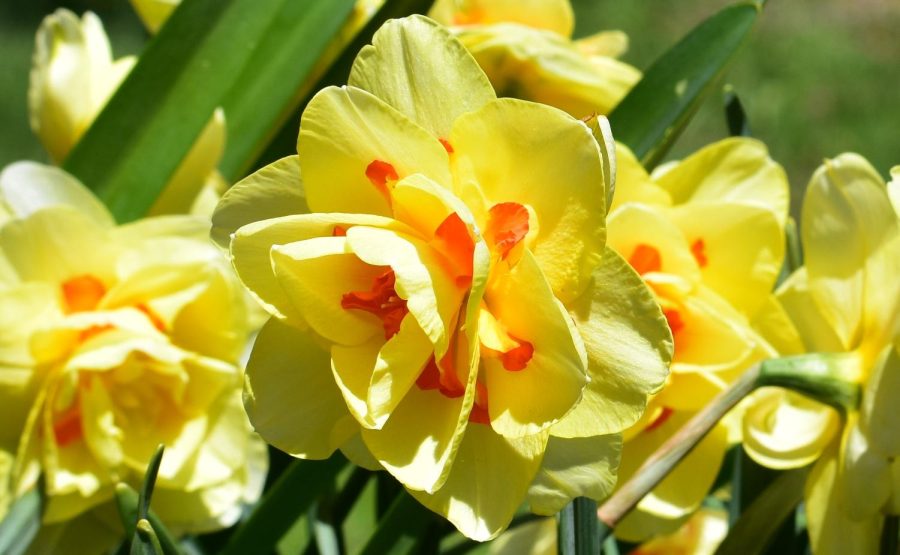Has Spring Sprung Too Early?
The Spring Equinox just passed, but spring has been here since February!
Photo by Susan Terletsky
Daffodils are one of the first flowers to bloom once spring begins. However, they have been blooming since February. When flowers bloom unusually early, the team at the Bayard Cutting Arboretum worries that they may be killed by frosts before spring officially begins.
Over the past couple of months, New York has seen unusual temperatures that have reached record highs for the winter months. In fact, the temperatures have reached such high levels during January and February that rather than seeing ice and snowstorms, we have seen flowers blooming and birds migrating back to Long Island early. Daffodils in February was a rude awakening for many people in our community to the intense effects of climate change, which is approaching at a faster pace than people realized.
However, this phenomenon is nothing new to Landscape Curator, Joy Arden, at Bayard Cutting Arboretum. Over the past couple months, she has noticed bulb plants, like daffodils, blooming unusually early, which is “tricky because every once in a while we’ll still get a frost” and unfortunately, “when the flowers come up, the frost will immediately kill the flowers.” However, after working at the arboretum for eight years, she has noticed that flowers are blooming earlier every year and “it’s been hard to judge when it’s going to happen.” Unfortunately, although flowers bloom earlier over time, they don’t always bloom predictably enough for the team at arboretum to adjust their planting schedules accordingly.
In addition to higher temperatures, Long Island’s vegetation has been forced to deal with frequent flooding. Arden explains that since Bayard Cutting Arboretum is a coastal garden, it brings its own challenges. Due to the flooding, the trees on the grounds have been having trouble handling all the wetness, “especially in the wintertime.” Furthermore, as the temperatures rise hurricanes grow more intense, and they can have drastic effects on local ecosystems. Arden recalled that “plants don’t love the salt,” which was apparent after Hurricane Isaias, where “there was so much salt spray that all the trees on the south shore of Long Island burnt to a crisp,” because the salt removed so much water from the plants’ cells that they completely dried up. According to Arden, “climate change is something we discuss in the arboretum every single day,” and there will likely be a “cultural shift” in Long Island’s plants because some plants “may be affected to the point that they won’t be able to grow here.” As a result, they have considered experimenting with native plants that are built for warmer, wetter conditions in their gardens.
While shifts in plant cycles may not seem significant, animals have been greatly affected by altering plant cycles and increasing temperatures. For instance, migratory animals that are returning early due to the higher temperatures have been negatively affected. Ms. Lenihan, an Agricultural Science teacher at Patchogue Medford High School, explained that as plants start to behave differently, “consumers begin to migrate early and when return there often isn’t enough food.” This would lead to an overall shift in Long Island’s ecosystem, as wildlife that thrives in cooler, dryer climates are replaced by animals that thrive in the island’s new warmer, wetter climate.
Concerningly, significant shifts in earth’s ecosystems are a widespread issue that doesn’t just affect Long Island. Although flooding is becoming a more urgent issue in coastal areas as storms worsen and the ocean level rises, as temperatures increase freshwater supplies are depleting. Much like the arboretum, there will likely be an agricultural shift to plants that are capable of handling higher temperatures and require less water. Ms. Lenihan worries that climate change could potentially lead to food shortages, but “anybody can grow food, and it may become necessary.“ She also hopes that in the future, scientists will develop an inexpensive method to filter salt water into freshwater to avoid food shortages and drastic agricultural shifts.
Unfortunately, climate change has caused irreversible changes in earth’s ecosystems. Ms. Lenihan says that humanity has to start focusing on slowing these effects and “adapting” to the changes we have already caused. Although these effects are permanent, there are ways our community can help slow further change. Arden encourages people to get outside and volunteer for different organizations to “take care of their green spaces because they help clean our air and help us as human beings get together and be kinder to each other.” She also reminds people that “we are very hard on ourselves, when it’s really the larger corporations that make this difficult.” While the perpetuation of issues caused by climate change can be discouraging, every member of our community can help. Through education, volunteerism, and the promotion of environmentally focused policies, our community can positively impact our local ecosystems.






